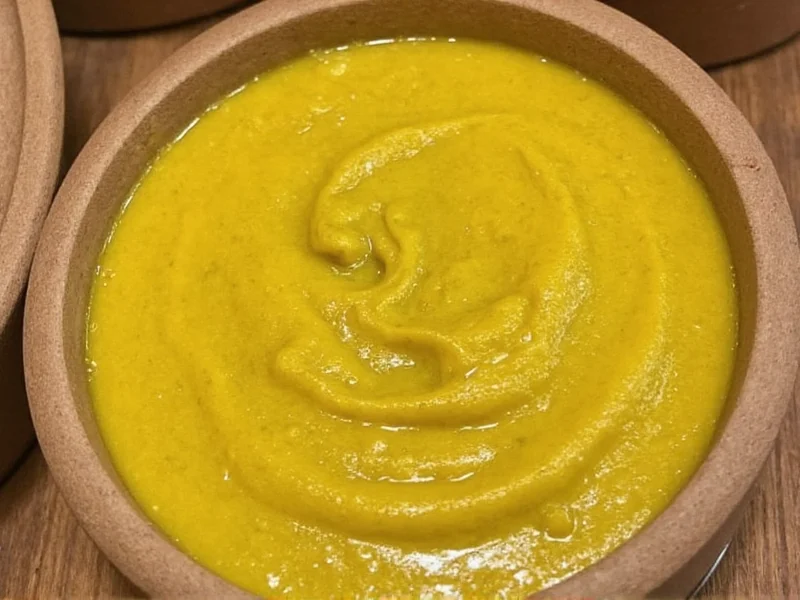Bavarian mustard represents one of Germany's most distinctive regional condiments, embodying the culinary traditions of southern Germany. This sweet mustard variety stands apart from other German mustards with its unique flavor profile that perfectly complements Bavaria's famous Weisswurst. Understanding what Bavarian mustard is requires examining its ingredients, preparation methods, and cultural significance within German cuisine.
Defining Bavarian Mustard: Ingredients and Characteristics
Authentic Bavarian mustard contains a specific blend of ingredients that create its signature taste. The base consists of yellow and brown mustard seeds, though the ratio differs from sharper German varieties. What makes Bavarian mustard special is the addition of sugar or honey, which creates its characteristic sweetness without overwhelming the mustard flavor. White wine vinegar provides acidity that balances the sweetness, while traditional spices like cloves, allspice, and sometimes a hint of lemon zest add complexity.
The texture of genuine Bavarian mustard is smooth and pourable, unlike coarse-textured mustards found in other German regions. This consistency makes it ideal for dipping Weisswurst, the traditional Bavarian white sausage that's never boiled after preparation. The mustard's mild heat level (typically 1-2 on a 10-point scale) allows the delicate flavors of the sausage to shine through.
| Mustard Type | Heat Level | Sweetness | Texture | Primary Region |
|---|---|---|---|---|
| Bavarian (Weißwurstsenf) | 1-2 | High | Smooth | Bavaria |
| Düsseldorf | 7-8 | Low | Coarse | Rhineland |
| Berlin | 5-6 | Moderate | Medium | Brandenburg |
| American Yellow | 3-4 | Moderate | Smooth | United States |
How Bavarian Mustard Differs from Other German Varieties
Understanding what Bavarian mustard is requires comparison with other regional German mustards. While Düsseldorf mustard delivers a sharp, sinus-clearing heat with coarse texture, Bavarian mustard offers a gentle sweetness that complements rather than overwhelms. The difference between Bavarian mustard and Düsseldorf mustard couldn't be more pronounced—one is designed to enhance delicate flavors, while the other makes a bold statement.
Berlin-style mustard occupies middle ground with moderate heat and some sweetness, but still lacks the distinctive spice profile of authentic Bavarian mustard. American yellow mustard, while somewhat similar in sweetness level, uses different spices and vinegar, resulting in a more one-dimensional flavor profile compared to the complex layers of traditional Bavarian preparation.
Traditional Uses in Bavarian Cuisine
The primary use of Bavarian mustard is as an accompaniment to Weisswurst, following the traditional "Frühschoppen" (morning drink) custom. Locals typically remove the sausage casing before eating and dip the sausage meat into the mustard. This practice dates back to the 19th century when Munich's butchers created Weisswurst as a way to use leftover veal and pork.
Beyond its classic pairing, Bavarian mustard serves multiple culinary purposes. Chefs use it as a base for salad dressings, particularly with potato salads. It also enhances meatloaf recipes and works beautifully as a glaze for roasted pork. Some creative home cooks even incorporate it into deviled eggs for a subtle German twist on the classic appetizer.
Authentic Bavarian Mustard Recipe Elements
While commercial Bavarian mustard is widely available, understanding what Bavarian mustard is made of reveals why homemade versions often surpass store-bought options. The authentic Bavarian mustard recipe includes specific proportions: approximately 60% yellow mustard seeds to 40% brown seeds, with sugar comprising about 15% of the total mixture. The vinegar must be white wine-based rather than distilled, and the spice blend typically follows a 3:2:1 ratio of mustard seeds to cloves to allspice.
Traditional preparation involves soaking the mustard seeds in vinegar for 24-48 hours before grinding, which develops flavor complexity. Unlike some commercial versions that use flour as a thickener, authentic Bavarian mustard relies solely on the natural binding properties of properly soaked and ground seeds.
Finding Authentic Bavarian Mustard
When searching for where to buy Bavarian mustard outside Germany, look for products labeled "Weißwurstsenf" or "Bayerischer Süßer Senf." Reputable German specialty stores and online retailers often carry authentic brands like Löwensenf or Düsseldorfer Löwensenf's Bavarian variety. Reading ingredient labels is crucial—true Bavarian mustard should list sugar or honey as the second ingredient after mustard seeds, with white wine vinegar rather than distilled vinegar.
For those interested in how to use Bavarian mustard beyond traditional applications, consider mixing it with mayonnaise for sandwiches or using it as a base for barbecue sauce. Its sweet profile makes it particularly versatile in recipes where you want mustard flavor without overwhelming heat.











 浙公网安备
33010002000092号
浙公网安备
33010002000092号 浙B2-20120091-4
浙B2-20120091-4